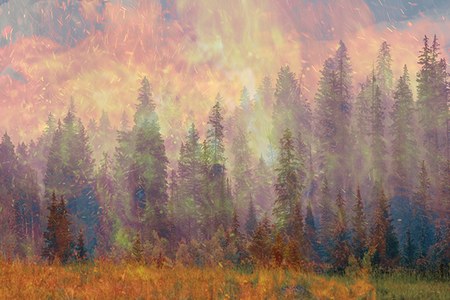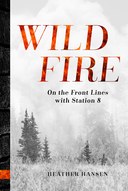
In Wildfire: On the Front Lines with Station 8, journalist and author Heather Hansen embeds with Boulder, Colorado's Station 8 fire crew and follows them through an entire season. From these professionals, she learns what it takes to protect us from these ever more frequent conflagrations. She also interviews those who study these fires to report the reasons for them and how we can do a better job of mitigating their destruction. Following is an excerpt from Heather's book.
PART II: COLD SPRINGS FIRE AND AFTERMATH
At 11 a.m. on day two of the Cold Springs Fire, Jamie Carpenter came off the fire line to get some rest. He had spent twenty-four near-sleepless hours, though it seemed like days, hiking around, chasing smoke. Carpenter’s brain and muscles desperately needed a break. Smith’s did also but he was committed to commanding the fire until Shane Greer’s team could take over that evening.
By midday the temperature was edging into the high 80s, the humidity was around 15 percent, and the wind was coming from the west with gusts up to 35 miles per hour. It was hotter and drier and windier than the day before, as predicted. Then came the moment Smith and his crew had been fearing. The fire shook off its slumber. Around 12:30 p.m., as if in salute to the sun directly overhead, the flames of Cold Springs rose. Huge, undulating waves of smoke gathered, dwarfing the engines, the planes, even the nearby peaks.
This was the “run” they’d hoped wouldn’t come. A running fire is one with a well-defined leading edge that’s advancing rapidly, often boosted by wind at its back. During a run often the entire fuel “complex” is engulfed—from the ground litter (pinecones, needles, dead leaves, and branches), up the so-called “ladder” of vegetation above, and finally into the crowns of trees. “The fire just stood up and started throwing spots all over the place,” said Smith. Some people standing outside the evacuation center downtown gasped. Dense masses of black smoke meant the fire was moving fast and had hit some heavy fuel—a pocket of trees, perhaps, or a home. Every so often there was a faint pop in the distance, like a muffled gunshot, that may have been a tire or a propane tank exploding. Hand crews did all they could just to get out of the fire’s way. Air-tankers and helicopters took turns trying to slow its advance toward three subdivisions.
The air space over the Cold Springs Fire was small. Up until then the helicopters and air tankers had been taking turns dropping water and slurry. “Then the fire blew up and went big,” said Doyle, still acting heli-base manager. So they divided the air space into north and south segments and started working the fire together. “Every helicopter we had on base ended up flying,” Doyle said. During that intense burn period he was in dialogue with air attack, finding out what they needed and directing the aircraft, juggling four radios to receive and relay critical information. At some point during the siege Sheriff Pelle told the press plainly, “Our objective is to not let this grow any more and pound the crap out of it.” Ultimately, the aircraft hit their marks consistently. “They’re pretty freaking good,” said Smith.
There was good and bad news heading into the afternoon community meeting in Nederland, where Sheriff Pelle addressed a packed gym. At this point, nearly 2,000 people had been evacuated. He looked more sprightly than most in his bright white ball cap and polo shirt, jeans and hiking shoes. He stood below the Nederland High School Panthers banner and held the microphone casually like he might be the principal at a pep rally. “You guys have an amazing bunch of local firefighters and fire managers that responded yesterday,” he said, to raucous applause and hooting from the crowd. “They are all standing here twenty-four hours later. No one’s been to bed,” said Pelle. He empathized with the residents who were stressed and aggravated, and said it was understandable they were eager for some good news.
That “good” news was that every available resource had been called in from across a five-state region. “No money or effort is being spared to put this fire out or to get it under control,” he said. “From the level of the county commissioners all the way up to the governor’s office, no one’s asked us to try to cut costs . . . or spare resources. They’re telling us to do what we need to do to put the fire out, to get it under control,” said Pelle. “So we’ve got a lot of support from the top on down,” he said, voice wavering.
Then came the bad news: “The fire is moving now, it’s spotting, it’s growing, they held it overnight but we’re at the mercy of the weather today,” Pelle said. And it appeared to be conspiring against them. He expressed confidence that crews would hold the fire inside “the box” above Ridge Road. “But there’s absolutely no guarantees if the wind comes up and starts carrying firebrands outside of the fire lines. We have an exhausted fire management team and exhausted local responders,” he explained. The federal Type 2 team would be taking over at 8:30 p.m., “So these guys can go home and take a shower and get some sleep.”
When IC trainee Ed LeBlanc took the microphone his speech was slow, deliberate. He assured the crowd that the crews were “right up against the red,” directly engaging the fire, despite conditions being unstable and extremely dry. The first questions from the audience were classic Nederland: Did they need volunteers to start digging? Did they need food? No and no, said LeBlanc. Then some questions indicating the anxiety level of the group came: How bad did the wind have to get before the aircraft were grounded? How would they know if they had lost their house? “We’ve got the best firefighters in the country here right now or coming this way for you guys,” he said. After another round of rumbling applause, they got back to work.
In spite of Sheriff Pelle’s optimism, the aircrafts’ arsenal-emptying efforts, and miles of hand line being dug, the head of the fire was insistent. Around 3 p.m. the fire plowed south and east across Ridge Road toward Boulder Canyon and dropped low into the slot. It was an alarming move, and Smith went back to incoming IC Shane Greer with a plea: “You need to get your people in place, get your division supervisors tied in with ours. We need horsepower,” said Smith.
It was a hard push and Greer mobilized his team. “They were right in our hip pocket; they were phenomenal,” said Smith. To his relief, the first twenty-member hotshot crew had landed about an hour earlier. The experience and fitness levels of those crews were just what Smith needed.
“I don’t have to worry about feeding and watering them,” he said. Smith also knew and trusted all the hotshot supervisors who were showing up. The crew was briefed and got down to the bottom of the canyon just as a spot fire demanded attention. They split into three squads: one went up the west flank, another up the east side, and a third stayed at the bottom. They dug lines straight up to the fire’s edge and burned along the bottom of the canyon to meet the wildfire on their terms.
The crisis was momentarily quashed, but then two spot fires flared up in the trees across the creek. Smith had to consider the very real possibility that these could move fire uphill toward Magnolia Road and even more homes. He had a fire behavior analyst run a computer model based on factors including slope, topography, fuels, fuel moisture level, temperature, and wind. The result was grim—if a spot fire established at the base of the south side of the canyon, it would take just thirty-five minutes before it reached those homes. Smith called for evacuations for all of Magnolia Road.
 Excerpted from Wildfire (Mountaineers Books, February 2018) by Heather Hansen. Pick up your copy of Wildfire today.
Excerpted from Wildfire (Mountaineers Books, February 2018) by Heather Hansen. Pick up your copy of Wildfire today.
 Mountaineers Books
Mountaineers Books